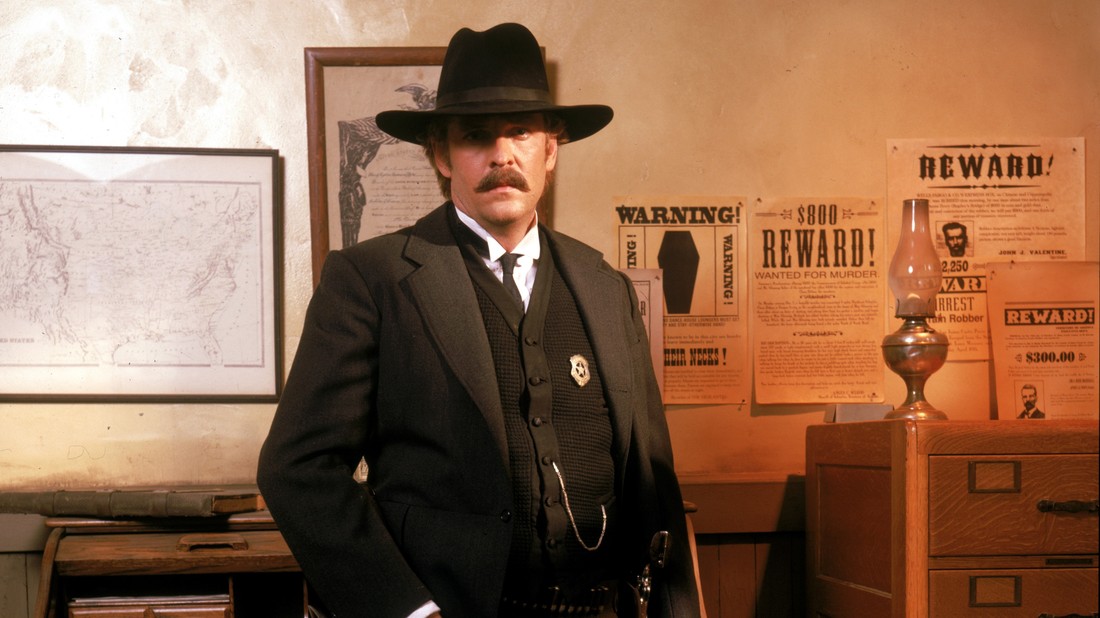Wyatt Earp (1994)

“Wyatt Earp,” a 1994 epic Western biographical drama directed and produced by Lawrence Kasdan, offers a sweeping portrayal of one of the most iconic figures of the American West. Co-written by Kasdan and Dan Gordon, the film chronicles the life of Wyatt Earp, from his humble beginnings as a farm boy in Iowa to his transformation into a formidable lawman. With a narrative that spans decades and touches on pivotal events such as the legendary gunfight at the O.K. Corral, “Wyatt Earp” aims to provide a detailed and nuanced portrayal of a man whose legacy has become emblematic of the American frontier spirit. This essay will explore the film’s plot, themes, character development, technical aspects, and its historical and cultural significance.
“Wyatt Earp” begins by depicting the early life of Wyatt Earp (played by Kevin Costner), focusing on his formative years in Iowa. The film shows Earp’s transition from a struggling farmer to a lawman with a fierce reputation. As the story unfolds, Earp moves westward in search of fortune and purpose, ultimately settling in Tombstone, Arizona—a town that would become central to his legendary career.
The film meticulously recounts the events leading up to the famous gunfight at the O.K. Corral, a confrontation between Earp and the outlaw Cowboys that became one of the most storied episodes in Western folklore. The narrative explores Earp’s complex relationships with his brothers, his struggles with personal loss, and the moral and ethical dilemmas he faces as a lawman in a lawless land.
The climax of the film is the O.K. Corral gunfight, which is portrayed as a pivotal moment in Earp’s life and career. The film concludes with a reflection on Earp’s later years and his eventual retirement, providing a comprehensive view of his life and legacy.
“Wyatt Earp” stands as a notable entry in the Western genre, particularly for its detailed and expansive approach to biographical storytelling. Unlike other Western films such as “Tombstone” (1993), which also depicts the events surrounding the O.K. Corral but with a more focused narrative, “Wyatt Earp” covers a broader scope of Earp’s life and career. The film’s epic length and detailed portrayal of historical events set it apart from other works that may concentrate more narrowly on specific incidents or character arcs.
When compared to other biographical Westerns, such as “The Searchers” (1956) and “Unforgiven” (1992), “Wyatt Earp” offers a more traditional and comprehensive narrative style. While “The Searchers” explores themes of vengeance and redemption through the character of Ethan Edwards, “Wyatt Earp” provides a broader historical context and focuses on the evolution of its protagonist over time. Similarly, “Unforgiven” examines the moral complexities of the Old West with a more contemporary lens, while “Wyatt Earp” remains rooted in a more classic depiction of the genre.
Several themes are central to “Wyatt Earp,” including the quest for justice, the complexities of law and order, and the personal costs of living a life defined by violence. The film delves into the moral ambiguity of Earp’s role as a lawman, exploring how his pursuit of justice often conflicts with personal values and the realities of frontier life.
The theme of family is also prominent, particularly in Earp’s relationships with his brothers. The film portrays the bonds between the Earp siblings as both a source of support and a catalyst for conflict, reflecting the complexities of familial loyalty in the face of external pressures and dangers.
Symbolically, the gunfight at the O.K. Corral represents the broader struggle between law and lawlessness. It serves as a focal point for the film’s exploration of Earp’s character and his role in shaping the history of the American West. The confrontation is depicted not merely as a violent clash but as a symbol of the larger battle between order and chaos in a frontier society.

Kevin Costner’s portrayal of Wyatt Earp is central to the film’s impact. Costner brings depth to Earp’s character, depicting him as a complex and morally conflicted individual. The film’s exploration of Earp’s early life, personal struggles, and professional challenges adds layers to his character, offering a nuanced view of his motivations and actions.
The supporting cast, including actors such as Dennis Quaid as Doc Holliday and Gene Hackman as Nicholas Earp, adds significant depth to the narrative. Doc Holliday’s friendship with Earp and his role in the O.K. Corral gunfight are portrayed with nuance, highlighting the personal and professional connections that shaped Earp’s life. Gene Hackman’s portrayal of Nicholas Earp, Wyatt’s father, provides a grounding influence and adds emotional weight to the film’s depiction of Earp’s family dynamics.

The film’s technical achievements contribute significantly to its epic scale and historical authenticity. Lawrence Kasdan’s direction is marked by a commitment to detailed storytelling and historical accuracy. The film’s cinematography, by Roger Deakins, captures the rugged landscapes of the American West with striking visuals, enhancing the film’s sense of place and time.
The production design and costumes are meticulously crafted to reflect the period setting, adding to the film’s authenticity. The attention to detail in recreating historical environments and attire helps immerse viewers in the world of the Old West.
The musical score, composed by James Newton Howard, complements the film’s dramatic and emotional tones. The score’s use of orchestral arrangements and thematic motifs enhances the narrative’s impact and underscores the film’s epic scope.

“Wyatt Earp” contributes to the cultural understanding of one of the American West’s most storied figures. By providing a comprehensive portrayal of Earp’s life and career, the film offers insights into the complexities of frontier law enforcement and the challenges faced by individuals who sought to impose order on a lawless land.
The film also reflects broader themes in Western cinema, including the exploration of heroism, justice, and the moral ambiguities of life on the frontier. “Wyatt Earp” stands as a significant work in the genre, offering a detailed and nuanced portrayal of a legendary figure and contributing to the ongoing cultural dialogue about the American West and its myths.

“Wyatt Earp” (1994), directed by Lawrence Kasdan and featuring Kevin Costner in the titular role, is a significant entry in the Western genre and biographical cinema. With its epic scope, detailed portrayal of historical events, and nuanced character development, the film provides a comprehensive view of one of the American West’s most iconic figures. By exploring themes of justice, family, and the personal costs of violence, “Wyatt Earp” offers a thought-provoking and immersive experience for viewers. Its technical achievements and historical significance further underscore its importance as both a cinematic work and a reflection on the legacy of Wyatt Earp.











